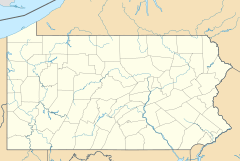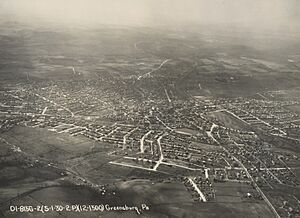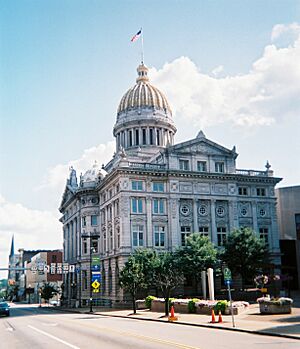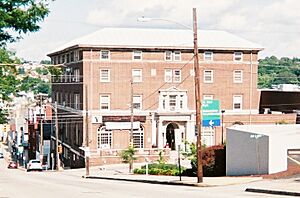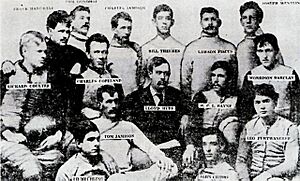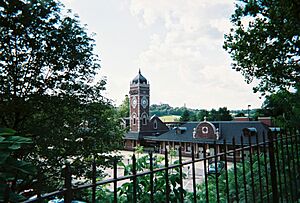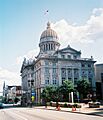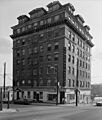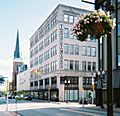Greensburg, Pennsylvania facts for kids
Quick facts for kids
Greensburg, Pennsylvania
|
|||
|---|---|---|---|
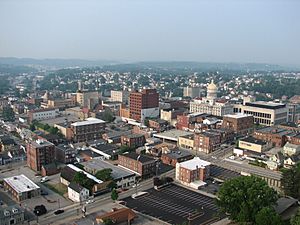
Downtown Greensburg
|
|||
|
|||
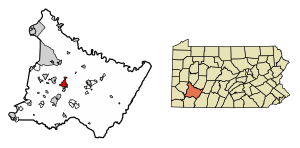
Location of Greensburg in Westmoreland County, Pennsylvania
|
|||
| Country | United States | ||
| State | Pennsylvania | ||
| County | Westmoreland | ||
| Incorporated | February 9, 1799 | ||
| Named for | Nathanael Greene | ||
| Government | |||
| • Type | Mayor-Council | ||
| • Body | Greensburg City Council | ||
| Area | |||
| • Total | 4.05 sq mi (10.50 km2) | ||
| • Land | 4.05 sq mi (10.50 km2) | ||
| • Water | 0.00 sq mi (0.00 km2) | ||
| Elevation | 1,017 ft (310 m) | ||
| Population
(2020)
|
|||
| • Total | 14,976 | ||
| • Density | 3,693.22/sq mi (1,425.80/km2) | ||
| • Demonym | Greensburger | ||
| Time zone | UTC−5 (EST) | ||
| • Summer (DST) | UTC−4 (EDT) | ||
| ZIP codes |
15601, 15605, 15606
|
||
| Area code(s) | 724, 878 | ||
| FIPS code | 42-31200 | ||
| GNIS feature ID | 1215700 | ||
| Website | www.greensburgpa.org | ||
Greensburg is a city in Pennsylvania, and it's the main town (called the county seat) of Westmoreland County. In 2020, about 14,976 people lived there.
It's about 30 miles southeast of Pittsburgh and is part of the larger Pittsburgh area. Greensburg is located in the Laurel Highlands region. The city is named after Nathanael Greene, a famous general from the American Revolutionary War.
Contents
History of Greensburg
After the American Revolutionary War ended, an inn was built along a wagon trail. This trail went from Philadelphia all the way to Fort Pitt (which is now Pittsburgh). A small settlement called Newtown grew around this inn. Today, this area is the center of Greensburg's business district.
The original county seat for Westmoreland County was a place called Hannastown. But in 1782, Hannastown was attacked and burned. So, officials decided to move the county seat. On December 10, 1785, they bought land in Newtown to build public buildings. This is why December 10, 1785, is seen as the day Newtown became the new county seat.
The first courthouse and jail were in one log building. Court meetings started there on January 7, 1787. The Westmoreland County Courthouse has been on this spot ever since. The area around the courthouse became known as Greensburg. It was named after General Nathanael Greene from the Revolutionary War. Greensburg officially became a borough on February 9, 1799. This made it the first borough in Westmoreland County.
In the early 1800s, Greensburg didn't grow much. But after 1850, it started to grow with more inns and businesses. A new railroad stop and the discovery of lots of soft coal nearby helped it become a big center for mining. Several coal mines opened around Greensburg in the late 1800s and early 1900s. Most of the coal was sent out by train.
Seton Hill College became a four-year women's school in 1918. Greensburg officially became a city on January 2, 1928. After World War II, more homes were built. Greensburg's cultural scene grew when the Westmoreland County Museum of Art opened in 1959. The University of Pittsburgh at Greensburg also opened a branch campus in 1963.
Shopping malls like Greengate Mall (1965) and Westmoreland Mall (1977) changed how people shopped. This hurt the smaller shops in Downtown Greensburg. By the 1990s, city leaders focused on bringing back Downtown Greensburg by improving its cultural spots. They restored the Palace Theater and the historic Train Station. A new performing arts center for Seton Hill University also opened. In 2009, a branch of the Lake Erie College of Osteopathic Medicine opened at Seton Hill University. The Westmoreland Museum of American Art also expanded in 2015.
Greensburg is also home to the Diocese of Greensburg, which is a Catholic church region.
Greensburg Neighborhoods
Greensburg has eight main areas called wards. Many of these used to be separate towns. For example, Bunker Hill (now Fifth Ward) joined Greensburg in 1894. Its name came from fights at a local tavern that were compared to the Battle of Bunker Hill.
In 1905, Greensburg added three more areas: Ludwick (now Sixth Ward), East Greensburg (now Seventh Ward), and Southeast Greensburg (also known as Paradise, Eighth Ward). Ludwick was named after an early settler, Ludwick Otterman. South Maple Avenue was once called Kinderhook (Third Ward). The Second Ward is the largest and includes neighborhoods like Saybrook Village and Northmont.
Hilltop, in the Eighth Ward, was first settled by Italian immigrants. The original Our Lady of Grace Church, built by Italian masons, is still there. The Hilltop Social Club was also started by families in this area. Every year, the firehall in the Eighth Ward holds a carnival with rides and famous "Shuey Burgers."
Two neighborhoods are recognized as U.S. historic districts: the Greensburg Downtown Historic District and the Academy Hill Historic District. The Greensburg Railroad Station and Westmoreland County Courthouse are also listed on the National Register of Historic Places.
Population Data
| Historical population | |||
|---|---|---|---|
| Census | Pop. | %± | |
| 1810 | 685 | — | |
| 1820 | 771 | 12.6% | |
| 1830 | 810 | 5.1% | |
| 1840 | 800 | −1.2% | |
| 1850 | 1,051 | 31.4% | |
| 1860 | 1,388 | 32.1% | |
| 1870 | 1,642 | 18.3% | |
| 1880 | 2,500 | 52.3% | |
| 1890 | 4,202 | 68.1% | |
| 1900 | 6,508 | 54.9% | |
| 1910 | 13,012 | 99.9% | |
| 1920 | 15,033 | 15.5% | |
| 1930 | 16,508 | 9.8% | |
| 1940 | 16,743 | 1.4% | |
| 1950 | 16,923 | 1.1% | |
| 1960 | 17,383 | 2.7% | |
| 1970 | 17,077 | −1.8% | |
| 1980 | 17,588 | 3.0% | |
| 1990 | 16,318 | −7.2% | |
| 2000 | 15,899 | −2.6% | |
| 2010 | 14,892 | −6.3% | |
| 2020 | 14,976 | 0.6% | |
| Sources: | |||
In 2000, Greensburg had 15,889 people living there. About 93% of the people were White, and nearly 4% were African American. The city had 7,144 households. About 24% of households had children under 18. The average age of people in Greensburg was 39 years old.
Economy and Business
Greensburg started as a railroad stop. In the late 1800s, it became a major center for coal mining. This helped the town grow with many businesses and inns. Downtown Greensburg used to have four big department stores, including JCPenney and Sears.
In 1965, Greengate Mall opened outside the city. This was one of the first indoor malls in the country. It changed shopping habits and hurt downtown businesses. Many local stores, like Troutman's, closed. However, the downtown area recovered. It became a center for service industries, offices, and banking. Today, downtown Greensburg has many small shops and restaurants.
Westmoreland Mall and Live! Casino Pittsburgh are now the biggest shopping and entertainment places in the area. Greengate Mall closed in 2003 and was replaced by a new shopping center called Greengate Centre, with a Walmart. Many other shopping centers and restaurants are along Route 30. Greensburg is now a major shopping area in Western Pennsylvania.
Light industries and service businesses are also strong in the Greensburg area. Most industrial parks are just outside the city. New homes continue to be built on the north side of Greensburg.
Major Employers
Three big companies have their main offices in the Greensburg area. These are Excela Health, Hillandale Farms, and the Tribune-Review newspaper. Also, nearly 300 people who work for the Pennsylvania Department of Labor and Industry have offices in Greensburg.
Arts and Culture
Greensburg is an important cultural center in Western Pennsylvania. It is home to the Westmoreland Museum of American Art. This museum focuses on American art from 1750 to 1950. The Palace Theatre in the city's cultural district hosts many shows all year. It is also where the Westmoreland Symphony Orchestra performs.
The Westmoreland Cultural Trust has helped a lot to improve Downtown Greensburg. They renovated the Palace Theatre and the Train Station. They also fixed up several other buildings downtown. Stage Right! offers musical theater classes for young people. They also put on professional shows at the Palace Theater. Greensburg Civic Theatre has been performing plays for over 60 years. The Performance Arts Center of Seton Hill University opened in 2009. This large building is expected to help the downtown area grow even more.
A hands-on science center was planned for downtown. It would have had many interactive exhibits. This center would have been the only one like it between Pittsburgh and Harrisburg. However, this project is currently on hold.
The World Conference Center for The Church of Jesus Christ is located west of Greensburg. It is the third-largest branch of the Latter Day Saint movement. The national office of the Kappa Delta Rho fraternity is also in Greensburg. The Saint Emma Monastery is a Catholic retreat house and monastery for the Sisters of Saint Benedict.
Education
Public Schools
The Greensburg area has two public school districts. The larger one is the Hempfield Area School District. This district covers about 95 square miles and has over 50,000 residents. It completely surrounds the city of Greensburg. Hempfield is the largest school district in Westmoreland County, with about 7,000 students.
The second school district is the Greensburg Salem School District. It covers 51 square miles. Greensburg Salem serves the City of Greensburg and nearby towns like South Greensburg and Southwest Greensburg. It has about 3,600 students.
Private Schools
Greensburg has two private Catholic schools: Greensburg Central Catholic High School and Aquinas Academy (www.aquinasacademy.org).
Colleges and Universities
Greensburg is home to two universities: Seton Hill University and the University of Pittsburgh at Greensburg. Seton Hill University was started in 1885 by the Sisters of Charity. It used to be a women's college but became coeducational in 2002. Seton Hill has been expanding into the downtown area with new buildings.
The Greensburg campus of the University of Pittsburgh opened in 1963. It grew into a large campus in nearby Hempfield Township. It was named "Best University in the Region" for eight years in a row by the Tribune-Review. Other colleges like Carlow University, Lake Erie College of Osteopathic Medicine, and Triangle Tech also have branches in the Greensburg area.
Saint Vincent College and Westmoreland County Community College are also located in nearby towns.
Libraries
The Greensburg Hempfield Area Library serves the City of Greensburg and Hempfield Township.
Media
Greensburg is close to Pittsburgh, so it receives radio and TV stations from that city. However, Greensburg also has its own local radio stations. Most of these local stations are owned by Broadcast Communications, Inc. (BCI). These include 103.1 WKVE, 103.9 WKHB-FM, 97.5 770 WKFB, and 92.3 620 WKHB. Station 620 WKHB was the first radio station in Westmoreland County, starting in 1934.
Renda Broadcasting also serves the area with 107.1 WHJB. This station has changed its name and music style many times over the years.
Greensburg's main newspaper is the Tribune-Review. In 1992, the company that owns it started the Pittsburgh Tribune Review. The Greensburg edition of the Tribune-Review still provides local news.
Sports in Greensburg
American Football
From 1890 to 1900, Greensburg had one of the first professional football teams, the Greensburg Athletic Association. It started as an amateur club but began paying players in 1895. The team was a big rival of the Latrobe Athletic Association.
In 1898, two players from Greensburg joined with Latrobe players to form the very first professional football all-star team. They played against the Duquesne Country and Athletic Club.
The Greensburg Athletic Association had many top players. Charlie Atherton is said to have invented the place kick. George Barclay invented the first football helmet. Isaac Seneca was the first Native American to earn All-American honors. Adam Martin Wyant became the first professional football player to be elected to the United States Congress.
Baseball
In 1907, Greensburg had a Minor League Baseball team called the Greensburg Red Sox. They played for one season. From 1934 to 1939, Greensburg was home to the Greensburg Red Wings. This team was connected to the St. Louis Cardinals, Brooklyn Dodgers, and Washington Senators. The team's name changed several times, including the Greensburg Trojans, Greensburg Green Sox, and Greensburg Senators.
Transportation
Highways
U.S. Route 30, a major east-west highway, goes around Greensburg to the south. Pennsylvania Turnpike 66, a north-south highway, goes to the west. The Pennsylvania Turnpike's New Stanton exit is about six miles south of Greensburg. The Irwin exit is seven miles west. PA Routes 66 and 136 start in Greensburg. PA Routes 130, 819, and U.S. Route 119 pass through the city. U.S. Route 22 is about seven miles north of the city.
Public Transportation
Westmoreland Transit is the mass transit system for Greensburg and Westmoreland County. It runs bus routes every day throughout the city, county, and to Pittsburgh. Greyhound Lines also has regular bus service to Greensburg from cities like Pittsburgh, Chicago, and New York City.
Airports
You can find air service at the Pittsburgh International Airport and the Arnold Palmer Regional Airport. The Arnold Palmer airport is east of Greensburg in Latrobe.
Rail
The city has Amtrak rail service at the restored Greensburg station. There is also freight rail service by Norfolk Southern and a smaller railroad that connects coal mines to the main line.
Bicycling
Greensburg is good for biking because it has the Five Star Trail. This trail starts at Lynch Field and goes south of the city to Armbrust.
City Services
Utilities
Electricity for Greensburg comes from West Penn Power. Natural gas is also widely used in the area. Peoples Natural Gas Company and Columbia Natural Gas Company provide this service. Water service is provided by the Municipal Authority of Westmoreland County (MAWC). Trash collection and sewage services are also available.
Medical Facilities
The Greensburg area has many medical facilities. These include clinics, urgent care centers, and full-service hospitals. Some of them are Excela Westmoreland Hospital and AHN Hempfield Hospital.
Telecommunications
Greensburg is in the 724 area code. In 2013, a new area code, 878, was added to the area.
Famous People from Greensburg
- Carroll Baker - actress
- K.C. Constantine - mystery writer
- Paul Gilbert - guitarist for the bands Racer X and Mr. Big
- Jesse Root Grant - father of President Ulysses S. Grant
- Rocco Mediate - professional golfer
- Vic Mignogna - voice actor
- Arthur St. Clair - Major General in the Revolutionary War
- Bruce Weber - fashion photographer
Sister Cities
Greensburg has two sister cities:
 – Belize City, Belize
– Belize City, Belize – Cercemaggiore, Molise
– Cercemaggiore, Molise
Images for kids
See also
 In Spanish: Greensburg (Pensilvania) para niños
In Spanish: Greensburg (Pensilvania) para niños




